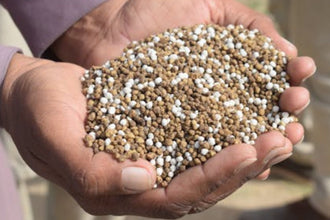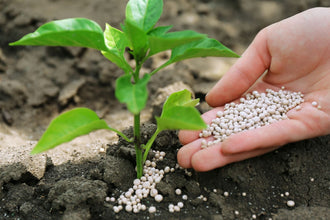Whether you're a seasoned green thumb or a budding gardener, the term '10 10 10 fertilizer' might have piqued your interest. This article ventures into the nitty-gritty of this well-known formula to address a frequent question: Is 10 10 10 fertilizer organic? Let's unearth the truth to foster a greener and more sustainable approach to gardening.
The Basics: What Does 10 10 10 Mean?
The numbers 10 10 10 you see on a fertilizer bag play a pivotal role in understanding its composition and how it can benefit your garden. Essentially, these numbers represent the percentage of three key nutrients crucial for plant growth: nitrogen (N), phosphorus (P), and potassium (K), respectively. This trio is often referred to as the N-P-K ratio, a universal standard for classifying fertilizers.
- Nitrogen (N): The first "10" in the sequence stands for nitrogen, making up 10% of the fertilizer's content. Nitrogen is vital for fostering healthy leaf and stem growth. It is the driving force behind the lush, green vibrancy of your plants, playing a critical role in photosynthesis.
- Phosphorus (P): The second "10" denotes phosphorus, which also constitutes 10% of the mix. Phosphorus supports the development of roots, flowers, and fruits. It's essential for energy transfer within the plant, helping to ensure robust growth from the ground up.
- Potassium (K): The final "10" signifies potassium, rounding off the trio with another 10% composition. Potassium aids in overall plant health, disease resistance, and water uptake. It is a key player in activating enzymes that regulate growth processes.
Benefits and Drawbacks of Using 10 10 10 Fertilizer
Navigating the world of gardening requires understanding the balance of nutrients your plants need to flourish. A 10 10 10 fertilizer offers several advantages but also possesses a few drawbacks that gardeners should be aware of.
Benefits
- Balanced Nutrition: Since a 10 10 10 fertilizer delivers equal proportions of nitrogen, phosphorus, and potassium, it provides a balanced dose of these primary nutrients. This makes it an excellent all-purpose fertilizer capable of meeting the basic nutritional requirements of many different types of plants.
- Versatility: This fertilizer can cater to various landscape settings. Whether you're maintaining a vegetable garden, lawn, flowerbed, or shrubbery, a 10 10 10 fertilizer offers a well-rounded nutrient solution.
- Easy Application: The equal ratio of essential nutrients simplifies application, reducing the need for separate or additional fertilizers to address specific deficiencies.
Drawbacks
- One-Size-Fits-All Approach: While being a universal fertilizer is generally seen as a benefit, this might not be an advantage in all situations. Different plants can have unique nutritional requirements. The 10 10 10 fertilizer's balanced ratio may not address the specific needs of certain plants or soils with significant nutrient imbalances or deficiencies.
- Potential Over-Fertilization: Without careful application, it's easy to overdo it with 10 10 10 fertilizer, which might lead to nutrient runoff and environmental pollution. Furthermore, over-fertilization can cause salt burn or nutrient toxicity in plants, adversely affecting their health and growth.
- Organic Concerns: As discussed earlier, whether a 10 10 10 fertilizer is organic or not depends on the source of its nutrients. Synthetic versions of this fertilizer could include chemicals that are potentially harmful to soil microbiology or contribute to environmental pollution over time.
As with any gardening tool, the key to utilizing 10 10 10 fertilizer effectively lies in understanding your garden's specific needs and using the fertilizer responsibly, in moderation, and under suitable circumstances.
Organic Alternatives to Traditional 10 10 10 Fertilizers
For gardeners committed to maintaining an organic landscape, it's essential to identify alternatives to traditional 10 10 10 fertilizers that might not align with organic gardening principles. Thankfully, Mother Nature has a lot in store for us. Here are some organic alternatives that can supply the key nutrients that plants need to thrive:
- Compost: One of the simplest ways to enrich your garden soil without resorting to synthetic fertilizers is to create compost. Stacked with a wealth of critical nutrients, well-rotted compost not only offers a balanced nutritional profile but encourages beneficial soil microorganisms that support plant health.
- Bone Meal: An excellent source of phosphorus, bone meal helps stimulate root development and bloom production. It also supplies additional calcium, another vital nutrient for plants.
- Blood Meal: A byproduct of the slaughter industry, blood meal is a powerhouse of nitrogen, excellent for encouraging lush green growth. It's especially beneficial for plants with high nitrogen needs.
- Fish Emulsion: Derived from the waste of the fish industry, fish emulsion offers a balanced N-P-K ratio and a variety of trace nutrients. It's a versatile organic fertilizer that would benefit any garden.
- Green Manure Cover Crops: Planting fast-growing cover crops such as clover or alfalfa, and then plowing them back into soil can supplement organic matter and nutrients, enhancing soil fertility.
- Organic Pelleted Fertilizers: Some commercially available organic fertilizers are formulated to provide a balanced N-P-K ratio and are compressed into pellets for easy application. An example is pelletized chicken manure.
Choosing to use organic alternatives to traditional 10 10 10 fertilizers requires an understanding of your soil's existing nutrient levels and your plants' needs. While organic fertilizers tend to release nutrients slowly over time, this ensures a steady supply of nourishment and minimizes the risk of nutrient overload that can harm plants and the environment.
Understanding Certifications and Regulations
Organic gardening is governed by various certifications and regulations designed to protect the environment, plants, animals, and humans. Here’s a deeper dive into the significance of understanding these frameworks:
Organic Certifications
Organic certifications guarantee that a product meets strict guidelines regarding its ingredients and production methods. These standards ensure that the products are free from synthetic chemicals and genetically modified organisms (GMOs).
In the United States, the USDA National Organic Program (NOP) is a key certification to look for when purchasing organic fertilizers. This certification assures consumers that the product complies with organic farming standards.
Regulations
Different regions have specific regulations concerning organic gardening and farming practices. These may include rules about soil conservation, pest management, and the use of additives.
Being aware of and adhering to these regulations not only ensures compliance but also promotes sustainable gardening practices. Regulations may vary significantly by location, so gardeners need to familiarize themselves with the rules in their specific area.
Best Practices for Organic Fertilizer Application
Employing the best practices for organic fertilizer application not only nurtures your plants but also preserves the ecological balance within your soil. Here are the essential steps to maximize the benefits of organic fertilization:
Know Your Soil
The first step in using any fertilizer wisely is to understand your soil's current condition. Conducting a soil test can give you detailed insights into its nutrient content, pH level, and texture. This information is crucial in determining what kind of organic fertilizer and application rate is best suited for your garden.
Right Timing
Organic fertilizers typically release nutrients slowly. Applying them at the right time ensures that the nutrients are available when the plants need them most. For instance, applying fertilizer in the early spring can bolster growth during the peak growing season.
Application Rate and Method
Follow the recommended application rates on fertilizer packaging to prevent over-fertilizing, which can lead to nutrient runoff and soil imbalance. Methods of application can vary; some fertilizers are meant to be diluted and used as a liquid solution, while others can be spread directly onto the soil and mixed in.
Composting and Mulching
Incorporating compost into your garden provides a rich, slow-releasing source of organic nutrients. Mulching with organic materials (like straw or wood chips) can suppress weeds, retain moisture, and gradually improve soil quality as they decompose.
Crop Rotation and Diversity
Practicing crop rotation and planting a variety of crops can naturally enhance soil fertility and prevent the depletion of specific nutrients. Different plants have varying nutrient needs and contribute differently to the soil's health.
Conclusion
In conclusion, whether 10 10 10 fertilizer is organic depends on its source and production process. For gardeners committed to maintaining an organic garden, it's crucial to scrutinize fertilizer components and opt for products certified as organic. If you're looking for an eco-friendly alternative that contributes to your garden's health without the use of synthetic chemicals, consider options like Fancy Chicken's pelletized organic chicken manure, a powerhouse of nutrients crafted with care for the conscious grower.
Ready to elevate your gardening the organic way? Look no further than Fancy Chicken's pelletized organic chicken manure fertilizer, perfect for eco-conscious gardeners looking to nourish their soil naturally. Packed with vital nutrients, this pure and potent formula promises to revitalize your garden while upholding your commitment to sustainability. Choose Fancy Chicken and witness a thriving, vibrant, and healthy garden unfold. Embrace the organic prowess today!








